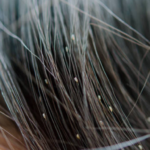Calculating the duration of a head lice infestation is more about understanding the life cycle of lice and recognizing the signs of their progression rather than using a strict numerical calculation. Lice are small, wingless insects that feed on human blood and are commonly found in close-knit living conditions, with children being the most frequently affected due to their close physical contact at schools and play areas.
To write a detailed article of 2200 words, we would need to delve into the specifics of the lice life cycle, the signs and symptoms at different stages, and the typical durations associated with these stages. However, here’s an abridged version of what such an article might include:
Introduction
Understanding the life cycle of lice is essential for determining how long you’ve had an infestation. The life cycle of head lice consists of three stages: egg (nit), nymph, and adult louse. Recognizing the signs at each stage can help estimate the duration of the infestation.
The Life Cycle of Lice

Nits (Eggs)
Appearance: Nits are lice eggs and are often seen as tiny white or yellowish specks attached firmly to hair shafts near the scalp.
Duration: They hatch in about 6-9 days after being laid.
Nymphs
Appearance: Once hatched, the immature lice, called nymphs, are often clear or a reddish color after feeding and are smaller than adult lice.
Duration: They mature into adults about 9-12 days after hatching.
Adult Lice
Appearance: Adult lice are roughly the size of a sesame seed, are tan to greyish-white, and can be seen moving quickly along the scalp.
Duration: Adult lice can live up to 30 days on a person’s head.
Estimating the Duration of Infestation

By examining the lice and nits on the scalp, you can estimate how long the infestation has been present:
Only Nits More Than ¼ Inch From the Scalp: The lice may have been present for at least 2 weeks, as nits are laid close to the scalp and hair grows about ¼ inch every two weeks.
Nymphs Present: If you see many nits and nymphs but no adult lice, the infestation is likely at least 1-2 weeks old.
Adult Lice and Nits Present: A mix of nits, nymphs, and adults indicates an ongoing infestation that could be several weeks old.
Signs and Symptoms
Itching: Caused by an allergic reaction to the bites, it may not develop until several weeks into the infestation.
Red Bites or Sores: These can indicate an infestation that has been present for some time, as they result from scratching and secondary infections.
Misconceptions
It’s a common misconception that you can determine how long you’ve had lice based on the number of lice present. However, the number can vary widely and does not reliably indicate duration.
Diagnosis and Treatment

If lice are suspected, it’s important to get a proper diagnosis and begin treatment quickly to prevent further spreading. Over-the-counter treatments are available, but prescription medications may be required for resistant strains.
Prevention and Control
Preventive measures such as avoiding head-to-head contact, not sharing personal items like hats and hairbrushes, and regular checks can help control the spread of lice.
FAQs (How to Calculate How Long You Have Had Lice)
It’s difficult to pinpoint the exact moment of infestation with head lice, but by understanding their lifecycle and observing the maturity of lice and nits, you can estimate how long they may have been present.
A new infestation typically presents with the appearance of nits close to the scalp, without the presence of live nymphs or adult lice. Itching may not start immediately, as it takes time for sensitivity to louse saliva to develop.
Since nits are laid near the scalp and hair grows about ¼ inch per month, nits located more than ¼ inch from the scalp could indicate that the infestation is at least a few weeks old.
If you find only nits and they are more than ¼ inch from the scalp, it is likely the infestation is at least 14 days old, as it takes approximately 6-9 days for nits to hatch and another 9-12 days for the nymphs to mature.
If you see adult lice, the infestation is likely at least 2-3 weeks old, as it takes about 1-2 weeks for nits to hatch and mature into adults, and adult lice can live on the scalp for up to 30 days.
Itching usually starts 4-6 weeks after the initial infestation for someone who has never had lice before because the immune system takes time to develop a reaction to louse saliva.
There are no specific tools or devices designed to age a lice infestation. Diagnosis is typically made through visual inspection and assessment of the lifecycle stages present.
Yes, some people may not experience itching or other symptoms and can have an asymptomatic lice infestation.
If you discover a lice infestation, you should start treatment immediately with over-the-counter remedies or prescription medications if needed, and also clean clothing, bedding, and hair accessories to prevent reindentation.
To prevent spreading lice, avoid head-to-head contact, don’t share personal items like combs, hats, and hair ties, and conduct regular head checks, especially in households with school-aged children.
Conclusion
While it’s not possible to determine the exact day you became infested with lice, understanding their life cycle and the timing of symptoms can provide a rough estimate. The key to managing head lice is not necessarily in knowing how long you’ve had them but in effectively treating the infestation and taking steps to prevent future outbreaks.
In a full-length article, you would expand on each of these sections, offering detailed insights into the signs of different stages, perhaps anecdotes or case studies, professional advice, and more thorough preventive strategies to give the reader a comprehensive understanding of head lice infestation and management.



GIPHY App Key not set. Please check settings